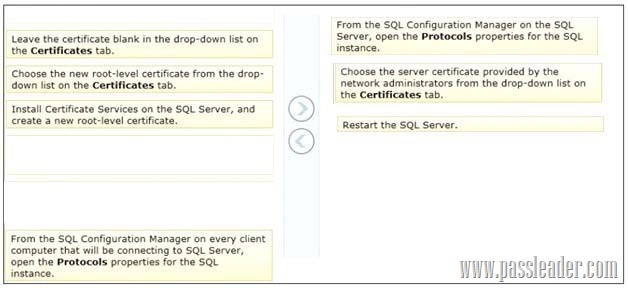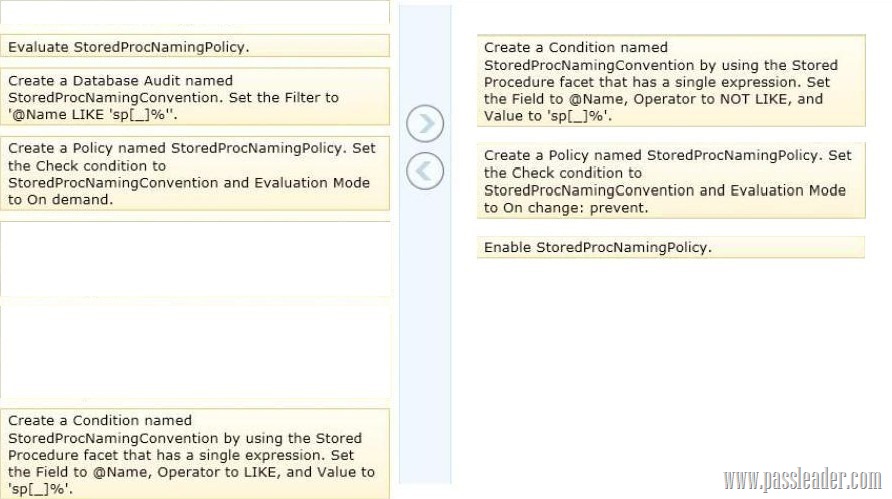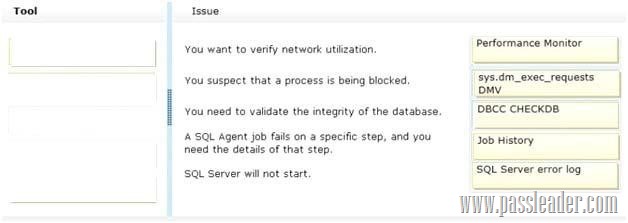Valid 70-462 Dumps shared by PassLeader for Helping Passing 70-462 Exam! PassLeader now offer the newest 70-462 VCE dumps and 70-462 PDF dumps, the PassLeader 70-462 exam questions have been updated and ANSWERS have been corrected, get the newest PassLeader 70-462 dumps with VCE and PDF here: http://www.passleader.com/70-462.html (254 Q&As Dumps –> 313 Q&As Dumps)
BTW, DOWNLOAD part of PassLeader 70-462 dumps from Cloud Storage: https://drive.google.com/open?id=0B-ob6L_QjGLpfmJwcE1qdzdiaWthUXB2N19xUE1SYU9sNVRSZzJPX3JzenFJZGVaY0J6VkU
QUESTION 1
You administer a Microsoft SQL Server 2012 database. The database has a table named Customers owned by UserA and another table named Orders owned by UserB. You also have a stored procedure named GetCustomerOrderInfo owned by UserB. GetCustomerOrderInfo selects data from both tables. You create a new user named UserC. You need to ensure that UserC can call the GetCustomerOrderInfo stored procedure. You also need to assign only the minimum required permissions to UserC. Which permission or permissions should you assign to UserC? Choose all that apply.
A. The Select permission on Customers
B. The Execute permission on GetCustomerOrderInfo
C. The Take Ownership permission on Customers
D. The Control permission on GetCustomerOrderInfo
E. The Take Ownership permission on Orders
F. The Select permission on Orders
Answer: AB
Explanation:
The question seems to be missing something. Or the original answer is incorrect. I’ve changed it to what I believe to be the correct answer. The original answer included “The Select permission on Orders.”, but due to ownership chaining, you would only need to give Execute permissions to UserC to access the Orders table since UserB is the owner.
Reference:
http://msdn.microsoft.com/en-us/library/ms188676.aspx
http://stackoverflow.com/questions/2212044/sql-server-how-to-permission-schemas
http://sqlservercentral.com/blogs/steve_jones/2012/03/14/ownership-chains-in-sql-server
QUESTION 2
You administer a Microsoft SQL Server 2012 database named ContosoDb. The database contains a table named Suppliers and a column named IsActive in the Purchases schema. You create a new user named ContosoUser in ContosoDb. ContosoUser has no permissions to the Suppliers table. You need to ensure that ContosoUser can delete rows that are not active from Suppliers. You also need to grant ContosoUser only the minimum required permissions. Which Transact-SQL statement should you use?
A. GRANT DELETE ON Purchases. Suppliers TC ContosoUser
B. CREATE PROCEDURE Purchases.PurgelnactiveSuppliers WITH EXECUTE AS USER = ‘dbo’
AS
DELETE FROM Purchases.Suppliers WHERE IsActive = 0
GO
GRANT EXECUTE ON Purchases.PurgelnactiveSuppliers TO ContosoUser
C. GRANT SELECT ON Purchases.Suppliers TO ContosoUser
D. CREATE PROCEDURE Purchases. PurgeInactiveSuppliers
AS
DELETE FROM Purchases.Suppliers WHERE IsActive = 0
GO
GRANT EXECUTE ON Purchases. PurgeInactiveSuppliers TO ContosoUser
Answer: B
Explanation:
http://msdn.microsoft.com/en-us/library/ms188354.aspx
http://msdn.microsoft.com/en-us/library/ms187926.aspx
QUESTION 3
You use a contained database named ContosoDb within a domain. You need to create a user who can log on to the ContosoDb database. You also need to ensure that you can port the database to different database servers within the domain without additional user account configurations. Which type of user should you create?
A. User mapped to a certificate
B. SQL user without login
C. Domain user
D. SQL user with login
Answer: C
Explanation:
Contained user
There are two types of users for contained databases:
– Contained database user with password
Contained database users with passwords are authenticated by the database.
– Windows principals
Authorized Windows users and members of authorized Windows groups can connect directly to the database and do not need logins in the master database. The database trusts the authentication by Windows.
QUESTION 4
You administer a Microsoft SQL Server 2012 database that has multiple tables in the Sales schema. Some users must be prevented from deleting records in any of the tables in the Sales schema. You need to manage users who are prevented from deleting records in the Sales schema. You need to achieve this goal by using the minimum amount of administrative effort. What should you do?
A. Create a custom database role that includes the users.
Deny Delete permissions on the Sales schema for the custom database role.
B. Include the Sales schema as an owned schema for the db_denydatawriter role.
Add the users to the db_denydatawriter role.
C. Deny Delete permissions on each table in the Sales schema for each user.
D. Create a custom database role that includes the users.
Deny Delete permissions on each table in the Sales schema for the custom database role.
Answer: A
QUESTION 5
You are the lead database administrator (DBA) of a Microsoft SQL Server 2012 environment. All DBAs are members of the DOMAIN\JrDBAs Active Directory group. You grant DOMAIN\JrDBAs access to the SQL Server. You need to create a server role named SpecialDBARole that can perform the following functions:
* View all databases.
* View the server state.
* Assign GRANT, DENY, and REVOKE permissions on logins.
You need to add DOMAIN\JrDBAs to the server role. You also need to provide the least level of privileges necessary. Which SQL statement or statements should you use? Choose all that apply.
A. CREATE SERVER ROLE [SpecialDBARole] AUTHORIZATION setupadmin;
B. ALTER SERVER ROLE [SpecialDBARole] ADD MEMBER [DOMAIN\JrDBAs];
C. CREATE SERVER ROLE [SpecialDBARole] AUTHORIZATION securityadmin;
D. GRANT VIEW DEFINITION TO [SpecialDBARole];
E. CREATE SERVER ROLE [SpecialDBARole] AUTHORIZATION serveradmin;
F. GRANT VIEW SERVER STATE, VIEW ANY DATABASE TO [SpecialDBARole];
Answer: BCF
QUESTION 6
Drag and Drop Question
You administer a Microsoft SQL Server 2012 database. All database traffic to the SQL Server must be encrypted by using secure socket layer (SSL) certificates or the connection must be refused. Network administrators have deployed server certificates to the Windows store of all Windows servers on the network from a trusted Certificate Authority. This is the only Certificate Authority allowed to distribute certificates on the network. You enable the Force Encryption flag for the MSSQLServer protocols, but client computers are unable to connect. They receive the following error message:
“A connection was successfully established with the server, but then an error occurred during the pre-login handshake, (provider: SSL Provider, error: 0 – The certificate chain was issued by an authority that is not trusted.) (Microsoft SQL Server)”
You notice the following entry in the SQL Server log:
“A self-generated certificate was successfully loaded for encryption.”
You need to configure SQL Server to encrypt all client traffic across the network. You also need to ensure that client computers are able to connect to the server by using a trusted certificate. Which three actions should you perform in sequence? (To answer, move the appropriate actions from the list of actions to the answer area and arrange them in the correct order.)
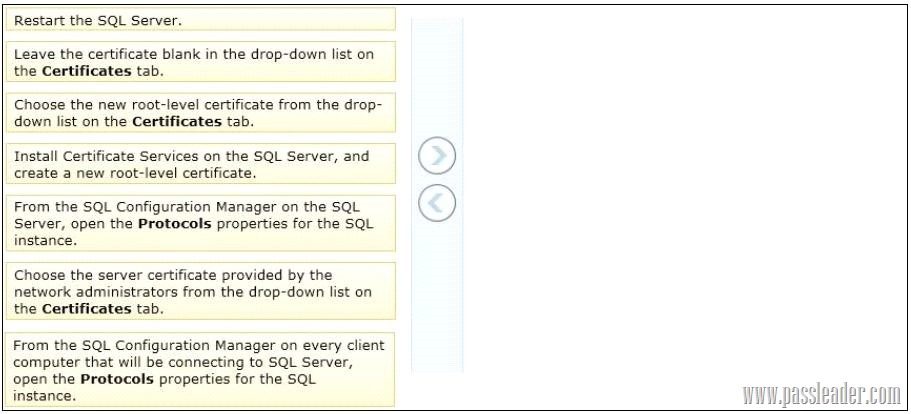
QUESTION 7
You administer a Microsoft SQL Server 2012 database that has Trustworthy set to On. You create a stored procedure that returns database-level information from Dynamic Management Views. You grant User1 access to execute the stored procedure. You need to ensure that the stored procedure returns the required information when User1 executes the stored procedure. You need to achieve this goal by granting the minimum permissions required. What should you do? (Each correct answer presents a complete solution. Choose all that apply.)
A. Create a SQL Server login that has VIEW SERVER STATE permissions.
Create an application role and a secured password for the role.
B. Modify the stored procedure to include the EXECUTE AS OWNER statement.
Grant VIEW SERVER STATE permissions to the owner of the stored procedure.
C. Create a SQL Server login that has VIEW SERVER STATE permissions.
Modify the stored procedure to include the EXECUTE AS {newlogin} statement.
D. Grant the db_owner role on the database to User1.
E. Grant the sysadmin role on the database to User1.
Answer: BC
Explanation:
Reference:
http://msdn.microsoft.com/en-us/library/ms187861.aspx
http://msdn.microsoft.com/en-us/library/ms191291.aspx
QUESTION 8
You are migrating a database named Orders to a new server that runs Microsoft SQL Server 2012. You attempt to add the [Corpnet\User1] login to the database. However, you receive the following error message:
“User already exists in current database.”
You need to configure the [Corpnet\User1] login to be able to access the Orders database and retain the original permissions. You need to achieve this goal by using the minimum required permissions. Which Transact-SQL statement should you use?
A. DROP USER [User1];
CREATE USER [Corpnet\User1] FOR LOGIN [Corpnet\User1];
ALTER ROLE [db_owner] ADD MEM3ER [Corpnet\User1];
B. ALTER SERVER RCLS Isysadmin] ADD MEMBER [Corpnet\User1];
C. ALTER USER [Corpnet\User1] WITH LOGIN [Corpnet\User1];
D. ALTER ROLE [db owner] ADD MEMBBR [Corpnet\User1];
Answer: C
QUESTION 9
You administer a Microsoft SQL Server 2012 database. You configure Transparent Data Encryption (TDE) on the Orders database by using the following statements:
– CREATE MASTER KEY ENCRYPTION BY PASSWORD = ‘MyPassword1!’;
– CREATE CERTIFICATE TDE_Certificate WITH SUBJECT = ‘TDE Certificate’;
– BACKUP CERTIFICATE TDE_Certificate TO FILE = ‘d:\TDE_Certificate.cer’;
– WITH PRIVATE KEY (FILE = ‘d:\TDE_Certificate.key’, ENCRYPTION BY PASSWORD = ‘MyPassword1!’);
– CREATE DATABASE ENCRYPTION KEY;
– WITH ALGORITHM = AES_256;
– ENCRYPTION BY SERVER CERTIFICATE TDE_Certificate;
– ALTER DATABASE Orders SET ENCRYPTION ON;
You attempt to restore the Orders database and the restore fails. You copy the encryption file to the original location. A hardware failure occurs and so a new server must be installed and configured. After installing SQL Server to the new server, you restore the Orders database and copy the encryption files to their original location. However, you are unable to access the database. You need to be able to restore the database. Which Transact-SQL statement should you use before attempting the restore?
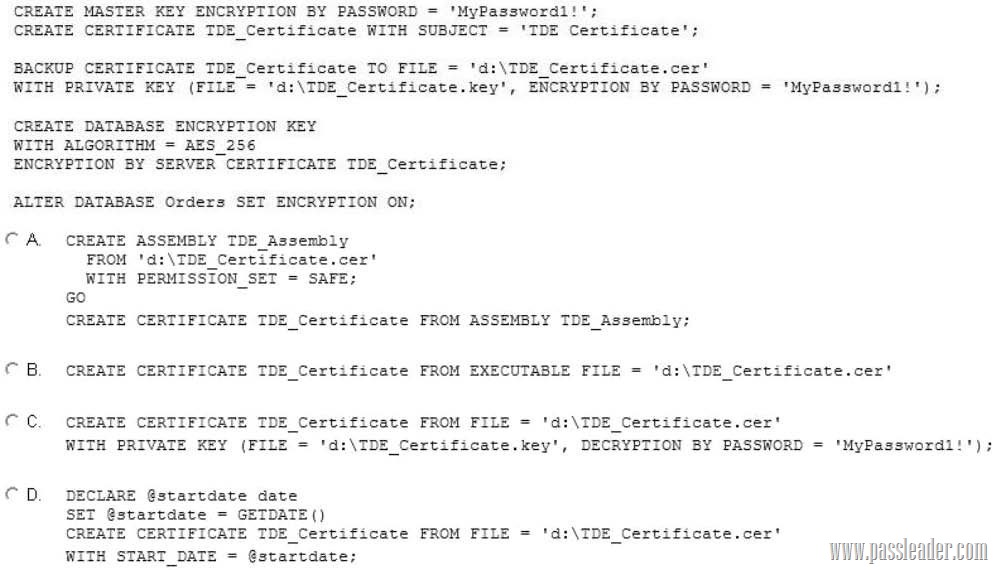
A. Option A
B. Option B
C. Option C
D. Option D
Answer: C
Explanation:
http://msdn.microsoft.com/en-us/library/ff773063.aspx
QUESTION 10
Drag and Drop Question
You administer a Microsoft SQL Server 2012 server that has multiple databases. You need to ensure that users are unable to create stored procedures that begin with sp_. Which three actions should you perform in sequence? (To answer, move the appropriate actions from the list of actions to the answer area and arrange them in the correct order.)
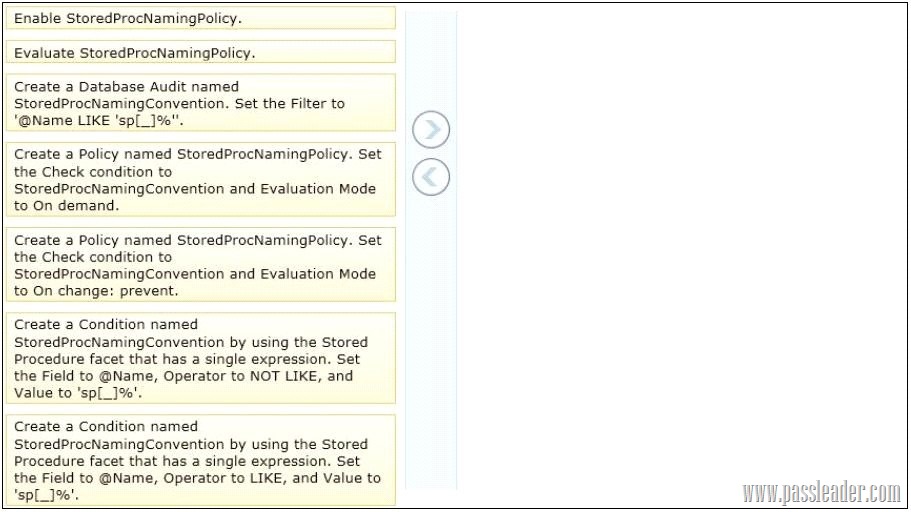
QUESTION 11
You administer a Microsoft SQL Server 2012 database. You provide temporary securityadmin access to User1 to the database server. You need to know if User1 adds logins to securityadmin. Which server-level audit action group should you use?
A. SERVER_STATE_CHANGE_GROUP
B. SERVER_PRINCIPAL_IMPERSONATION_GROUP
C. SUCCESSFUL_LOGIN_GROUP
D. SERVER_ROLE_MEMBER_CHANGE_GROUP
Answer: D
Explanation:
http://technet.microsoft.com/en-us/library/cc280663.aspx
SERVER_STATE_CHANGE_GROUP
This event is raised when the SQL Server service state is modified. Equivalent to the Audit Server Starts and Stops Event Class.
SERVER_PRINCIPAL_IMPERSONATION_GROUP
This event is raised when there is an impersonation within server scope, such as EXECUTE AS <login>. Equivalent to the Audit Server Principal Impersonation Event Class.
SUCCESSFUL_LOGIN_GROUP
Indicates that a principal has successfully logged in to SQL Server. Events in this class are raised by new connections or by connections that are reused from a connection pool. Equivalent to the Audit Login Event Class.
SERVER_ROLE_MEMBER_CHANGE_GROUP
This event is raised whenever a login is added or removed from a fixed server role. This event is raised for the sp_addsrvrolemember and sp_dropsrvrolemember stored procedures. Equivalent to the Audit Add Login to Server Role Event Class.
QUESTION 12
You administer a Microsoft SQL Server 2012 instance. You need to stop a blocking process that has an SPID of 64 without stopping other processes. What should you do?
A. Execute the following Transact-SQL statement:
EXECUTE sp_KillSPID 64
B. Restart the SQL Server service.
C. Execute the following Transact-SQL statement:
KILL 64
D. Execute the following Transact-SQL statement:
ALTER SESSION KILL ’64’
Answer: C
Explanation:
http://msdn.microsoft.com/en-us/library/ms173730.aspx
QUESTION 13
Drag and Drop Question
You administer a Microsoft SQL Server 2012 server. A variety of issues occur from time to time in the production environment. You need to identify the appropriate tool for each issue. Which tool or tools should you use? (To answer, drag the appropriate tool or tools to the correct issue or issues in the answer area. Each tool may be used once, more than once, or not at all. You may need to drag the split bar between panes or scroll to view content.)
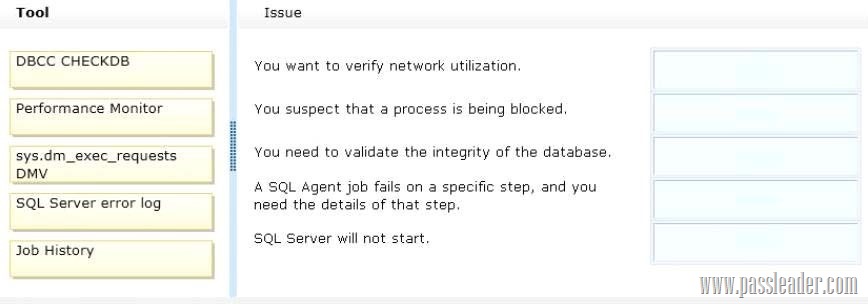
QUESTION 14
You administer a Microsoft SQL Server 2012 database. Users report that an application that accesses the database displays an error, but the error does not provide meaningful information. No entries are found in the SQL Server log or Windows event logs related to the error. You need to identify the root cause of the issue by retrieving the error message. What should you do?
A. Create an Extended Events session by using the sqlserver.error_reported event.
B. Create a SQL Profiler session to capture all ErrorLog and EventLog events.
C. Flag all stored procedures for recompilation by using sp_recompile.
D. Execute sp_who.
Answer: A
Explanation:
http://msdn.microsoft.com/en-us/library/bb630282.aspx
Event sqlserver.error_reported: This event gets fired every time that an error happens in the server.
QUESTION 15
You administer a Microsoft SQL Server 2012 server. One of the databases on the server supports a highly active OLTP application. Users report abnormally long wait times when they submit data into the application. You need to identify which queries are taking longer than 1 second to run over an extended period of time. What should you do?
A. use SQL Profiler to trace all queries that are processing on the server.
Filter queries that have a Duration value of more than 1,000.
B. Use sp_configure to set a value for blocked process threshold.
Create an extended event session.
C. Use the Job Activity monitor to review all processes that are actively running.
Review the Job History to find out the duration of each step.
D. Run the sp_who command from a query window.
E. Run the DBCC TRACEON 1222 command from a query window and review the SQL Server event log.
Answer: E
Explanation:
Verified the SQL Profiler and DBCC answers as correct. However, while Profiler will show this information, the best practice with Profiler is to use it short-term. The question specifically states “over an extended period of time”. That means Profiler wouldn’t be the best tool for this scenario. Therefore, DBCC would be the best answer.
http://www.mssqltips.com/sqlservertip/2130/finding-sql-server-deadlocks-using-trace-flag-1222/
http://msdn.microsoft.com/en-us/library/ms188396.aspx
QUESTION 16
Drag and Drop Question
You administer a Microsoft SQL Server database that is used by an application. Users of the application report performance issues. You need to choose the appropriate tool for performance-tuning of SQL Server databases. Which tool or tools should you use? (To answer, drag the appropriate tool or tools to their corresponding task or tasks in the answer area. Each tool may be used once, more than once, or not at all. You may need to drag the split bar between panes or scroll to view content.)

QUESTION 17
You administer a Microsoft SQL Server 2012 database. You need to ensure that the size of the transaction log file does not exceed 2GB. What should you do?
A. Execute sp_configure ‘max log size’, 2G.
B. use the ALTER DATABASE … SET LOGFILE command along with the maxsize parameter.
C. In SQL Server Management Studio, right-click the instance and select Database Settings.
Set the maximum size of the file for the transaction log.
D. in SQL Server Management Studio, right-click the database, select Properties, and then click Files.
Open the Transaction log Autogrowth window and set the maximum size of the file.
Answer: D
QUESTION 18
You administer a Microsoft SQL Server 2012 server. The MSSQLSERVER service uses a domain account named CONTOSO\SQLService. You plan to configure Instant File Initialization. You need to ensure that Data File Autogrow operations use Instant File Initialization. What should you do? Choose all that apply.
A. Restart the SQL Server Agent Service.
B. Disable snapshot isolation.
C. Restart the SQL Server Service.
D. Add the CONTOSO\SQLService account to the Perform Volume Maintenance Tasks local security policy.
E. Add the CONTOSO\SQLService account to the Server Operators fixed server role.
F. Enable snapshot isolation.
Answer: CD
Explanation:
http://msdn.microsoft.com/en-us/library/ms175935.aspx
http://www.mssqltips.com/sqlservertip/2752/effect-of-instant-file-initialization-within-sql-server/
How To Enable Instant File Initialization
1. Open Local Security Policy and go to Local Policies -> User Rights Assignment.
2. Double click Perform Volume Maintenance Tasks and add your SQL Server database engine service account.
3. Restart the SQL Server service using SQL Server Configuration Manager and this setting should now be enabled.
QUESTION 19
Drag and Drop Question
You administer a single Microsoft SQL Server instance on a two-node failover cluster that has nodes named Node A and Node B. The instance is currently running on Node A. You want to patch both Node A and Node B by using the most recent SQL Server Service Pack. You need to ensure that the following requirements are met:
– Both nodes receive the update.
– Downtime is minimized.
– No data is lost.
Which three actions should you perform in sequence? (To answer, move the appropriate actions from the list of actions to the answer area and arrange them in the correct order.)

QUESTION 20
You administer a Microsoft SQL Server 2012 failover cluster that contains two nodes named Node A and Node B. A single instance of SQL Server is installed on the cluster. An additional node named Node C has been added to the existing cluster. You need to ensure that the SQL Server instance can use all nodes of the cluster. What should you do?
A. Run the New SQL Server stand-alone installation Wizard on Node C.
B. Run the Add Node to SQL Server Failover Cluster Wizard on Node C.
C. Use Node B to install SQL Server on Node C.
D. Use Node A to install SQL Server on Node C.
Answer: B
Explanation:
http://technet.microsoft.com/en-us/library/ms191545.aspx
To add a node to an existing SQL Server failover cluster, you must run SQL Server Setup on the node that is to be added to the SQL Server failover cluster instance. Do not run Setup on the active node. The Installation Wizard will launch the SQL Server Installation Center. To add a node to an existing failover cluster instance, click Installation in the left-hand pane. Then, select Add node to a SQL Server failover cluster.
Get the newest PassLeader 70-462 VCE dumps here: http://www.passleader.com/70-462.html (254 Q&As Dumps –> 313 Q&As Dumps)
And, DOWNLOAD the newest PassLeader 70-462 PDF dumps from Cloud Storage for free: https://drive.google.com/open?id=0B-ob6L_QjGLpfmJwcE1qdzdiaWthUXB2N19xUE1SYU9sNVRSZzJPX3JzenFJZGVaY0J6VkU
